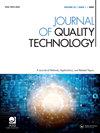Online automatic anomaly detection for photovoltaic systems using thermography imaging and low rank matrix decomposition
IF 2.2
2区 工程技术
Q2 ENGINEERING, INDUSTRIAL
引用次数: 14
Abstract
Abstract Faults occurred during the operational lifetime of photovoltaic (PV) systems can cause energy loss, system shutdown, as well as possible fire risks. Therefore, it is crucial to detect anomalies and faults to control the system’s performance and ensure its reliability. Comparing to traditional monitoring techniques based on an on-site visual inspection and/ or electrical measuring devices, the combination of drones and infrared thermography imaging evidently provides the means for faster and less expensive PV monitoring. However, the literature in this area lacks automatic and implementable algorithms for PV fault detection, particularly, using raw aerial thermography, with precise performance evaluation. The objective of this paper is, thus, to build a fully automatic online monitoring framework. We propose an analytical framework for online analysis of the raw video streams of aerial thermography. This framework integrates image processing and statistical machine learning techniques. We validate the effectiveness of the proposed framework and provide sufficient details to facilitate its implementation by practitioners. Two challenges hinder direct fault detection on raw PV images. One is that raw PV images often have non-smooth backgrounds that can impact the detection performance. This background needs to be removed before fault detection. However, this is a daunting task given the perspective of images. To deal with this challenge, we utilize the Transform Invariant Low-rank Textures (TILT) method to orthogonalize the perspective before applying edge detection to crop out the background and aligning the cropped images. The other issue is that the regular hot spots at the bottom edges of the solar panels are normal and should not be detected as anomalies. This makes the intensity-based detection method in the literature fail. These hot spots are part of the low-rank pattern of the image sequence. On the other hand, the hot spots caused by anomalies deviate from the normal low-rank pattern of the PV cells. Therefore, we propose a methodology that relies on Robust Principal Component Analysis (RPCA), which can separate sparse corrupted anomalous components from a low-rank background. The RPCA is applied to the PV images for simultaneous detection and isolation of anomalies. In addition to RPCA, we suggest a set of post-processing procedures for image denoising, and segmentation. The proposed algorithm is developed using 20 normal (with no anomalies) training samples and 100 test samples. The results showed that the algorithm successfully detects the anomalies with a recall of 0.80 and detects the significant anomalies with the maximum recall of 1. Our method outperforms two benchmark methods in terms of F1 score by 44.5% and 114.3%. The small number of false alarms is mostly due to irregular image patterns at the end of a PV array or an extreme non-orthogonal perspective. Since the number of false alarms is not large, it does not disrupt the inspection process, and they can easily be identified by an appraiser offline. The average computation time is 6.32 sec/image, which enables online automatic inspection of PV panels.基于热成像和低秩矩阵分解的光伏系统在线自动异常检测
光伏发电系统在使用寿命期间发生的故障会造成能量损失、系统停机,并可能存在火灾风险。因此,检测异常和故障是控制系统性能和保证系统可靠性的关键。与基于现场目视检查和/或电气测量设备的传统监测技术相比,无人机和红外热成像的结合显然提供了更快、更便宜的光伏监测手段。然而,该领域的文献缺乏用于光伏故障检测的自动和可实现的算法,特别是使用原始航空热像仪进行精确的性能评估。因此,本文的目标是构建一个全自动在线监测框架。我们提出了一个分析框架,用于在线分析航空热成像的原始视频流。该框架集成了图像处理和统计机器学习技术。我们验证建议框架的有效性,并提供足够的细节,以方便从业员实施。两个挑战阻碍了对原始PV图像的直接故障检测。首先,原始PV图像通常具有不光滑的背景,这会影响检测性能。在进行故障检测前,需要清除该背景。然而,考虑到图像的视角,这是一项艰巨的任务。为了应对这一挑战,我们利用变换不变低秩纹理(TILT)方法对透视进行正交化,然后应用边缘检测裁剪背景并对齐裁剪后的图像。另一个问题是,太阳能电池板底部边缘的常规热点是正常的,不应该被检测为异常。这使得文献中基于强度的检测方法失效。这些热点是图像序列低秩模式的一部分。另一方面,异常引起的热点偏离了PV电池正常的低秩模式。因此,我们提出了一种基于鲁棒主成分分析(RPCA)的方法,该方法可以从低秩背景中分离稀疏的损坏异常成分。将RPCA应用于PV图像,同时检测和隔离异常。除了RPCA之外,我们还提出了一套用于图像去噪和分割的后处理程序。该算法使用20个正常(无异常)训练样本和100个测试样本开发。结果表明,该算法以0.80的召回率成功检测异常,以1的最大召回率成功检测显著异常。在F1得分方面,我们的方法比两种基准方法分别高出44.5%和114.3%。少量误报主要是由于PV阵列末端的不规则图像模式或极端非正交视角造成的。由于假警报的数量并不多,它不会破坏检查过程,并且它们可以很容易地被鉴定人员离线识别。平均计算时间为6.32秒/张,实现对光伏板的在线自动检测。
本文章由计算机程序翻译,如有差异,请以英文原文为准。
求助全文
约1分钟内获得全文
求助全文
来源期刊

Journal of Quality Technology
管理科学-工程:工业
CiteScore
5.20
自引率
4.00%
发文量
23
审稿时长
>12 weeks
期刊介绍:
The objective of Journal of Quality Technology is to contribute to the technical advancement of the field of quality technology by publishing papers that emphasize the practical applicability of new techniques, instructive examples of the operation of existing techniques and results of historical researches. Expository, review, and tutorial papers are also acceptable if they are written in a style suitable for practicing engineers.
Sample our Mathematics & Statistics journals, sign in here to start your FREE access for 14 days
 求助内容:
求助内容: 应助结果提醒方式:
应助结果提醒方式:


